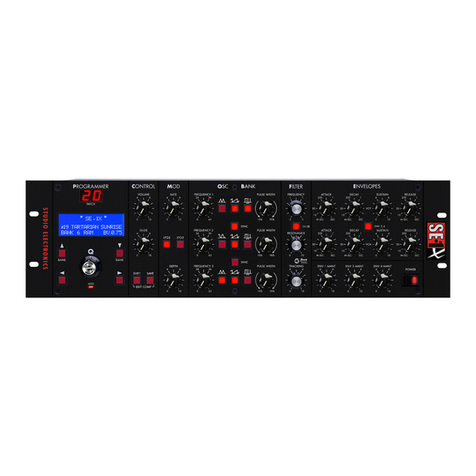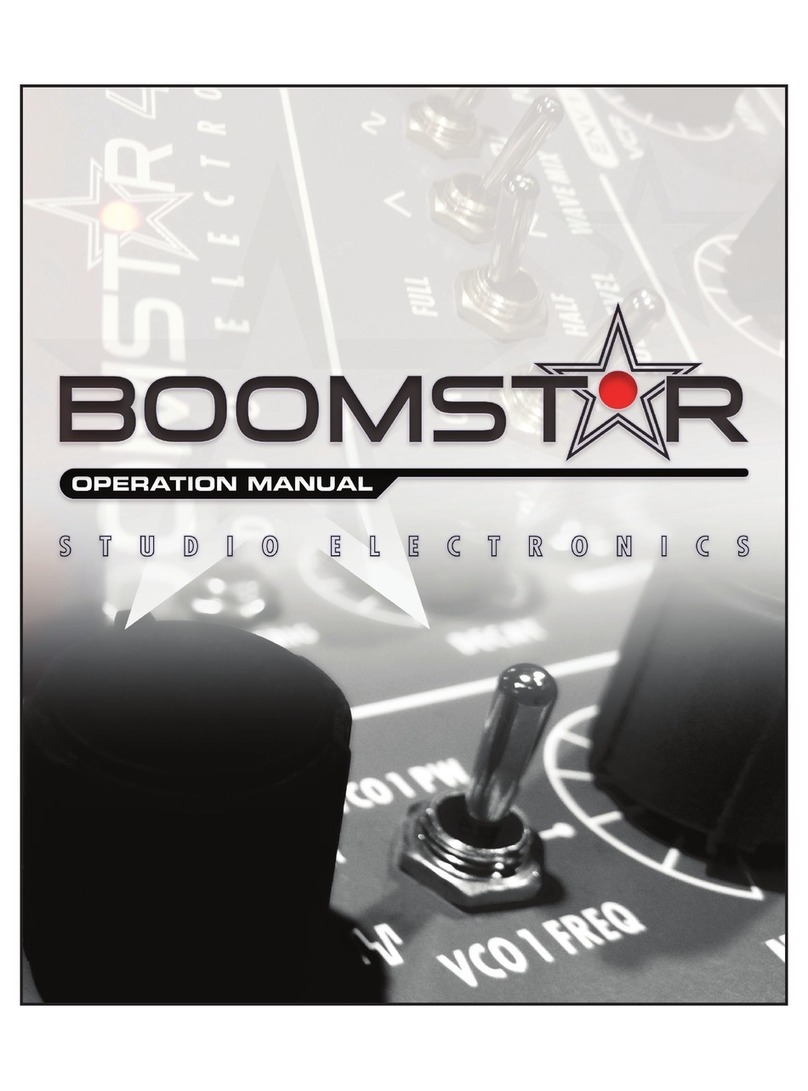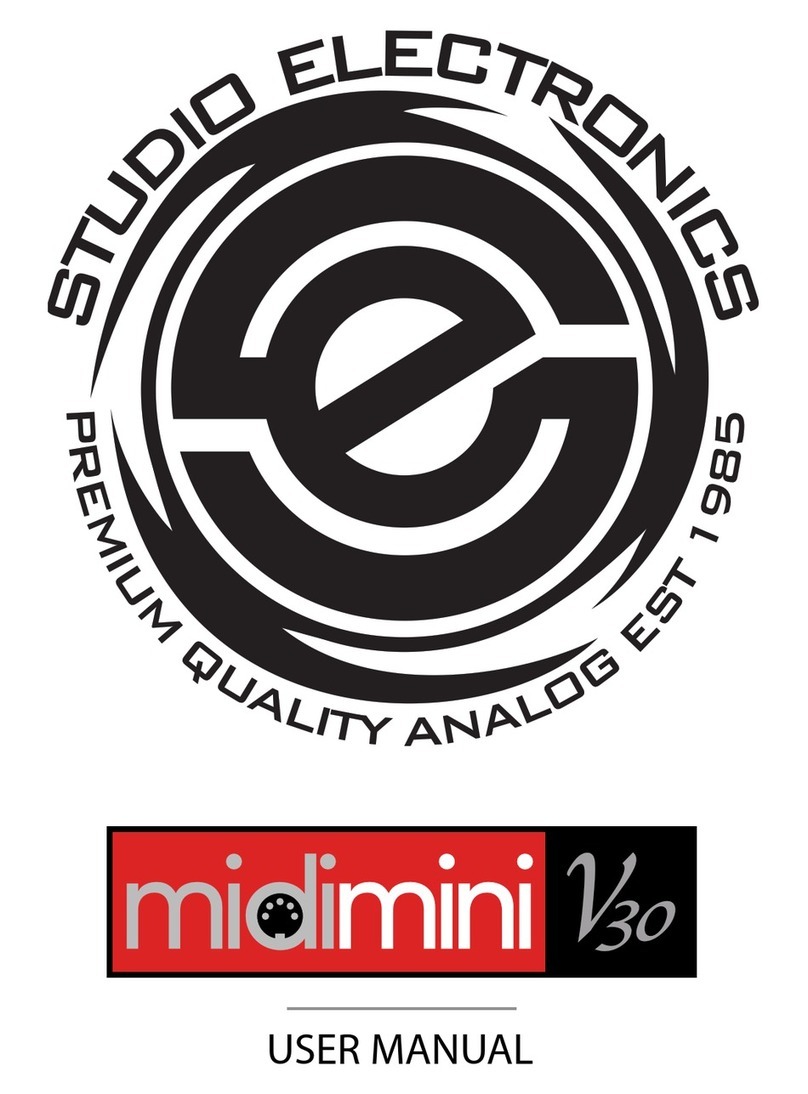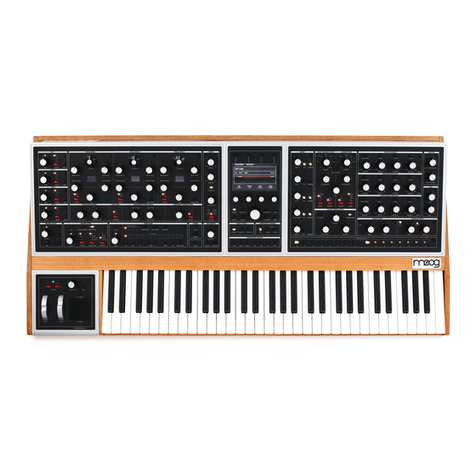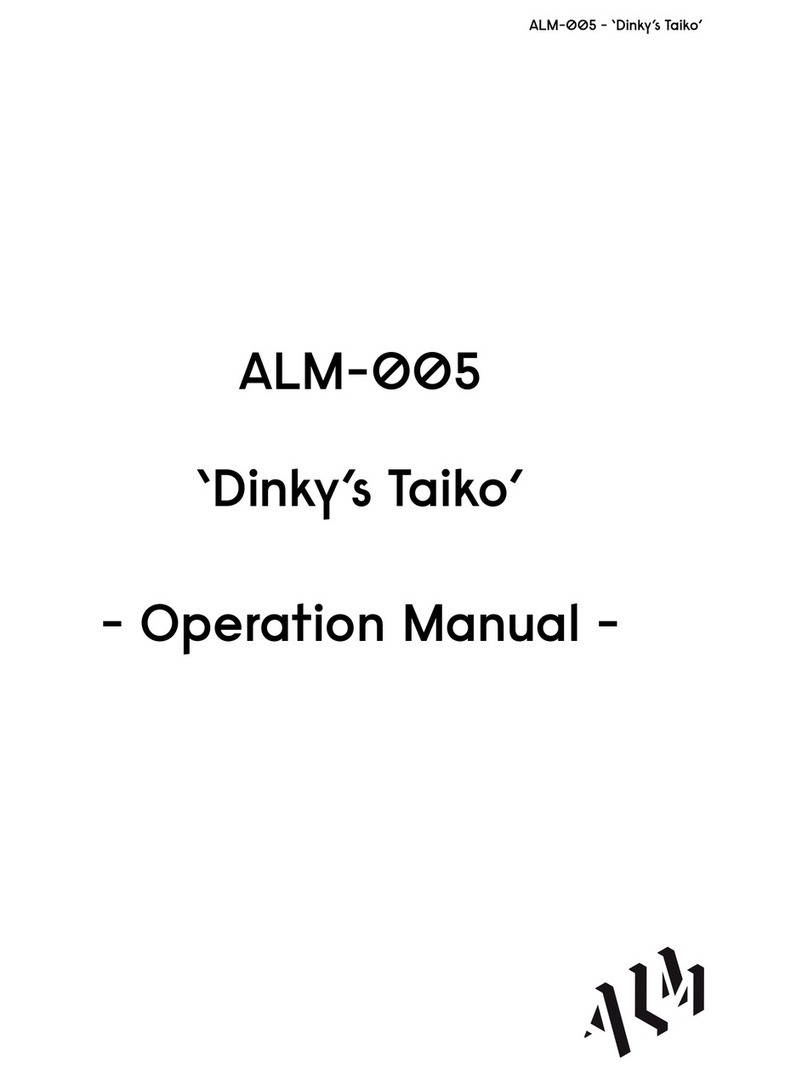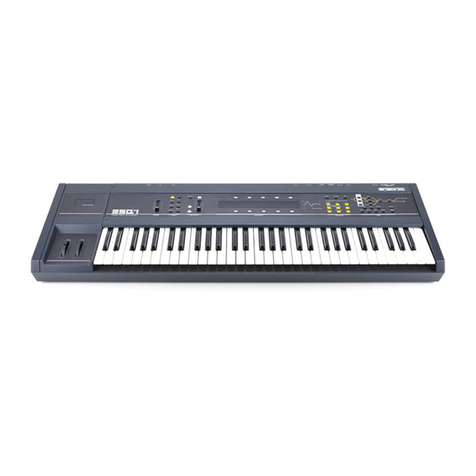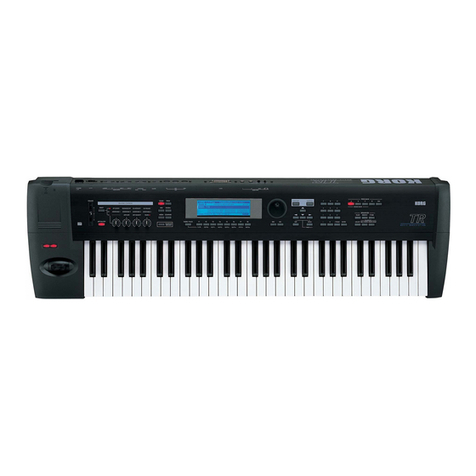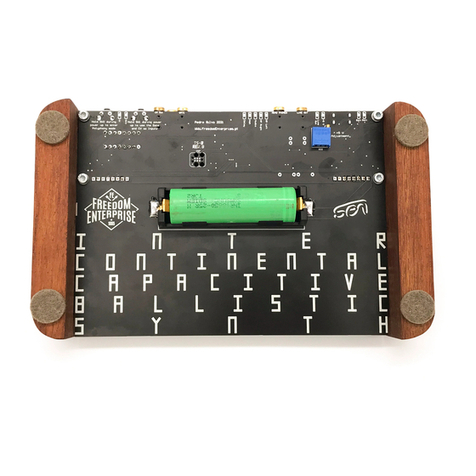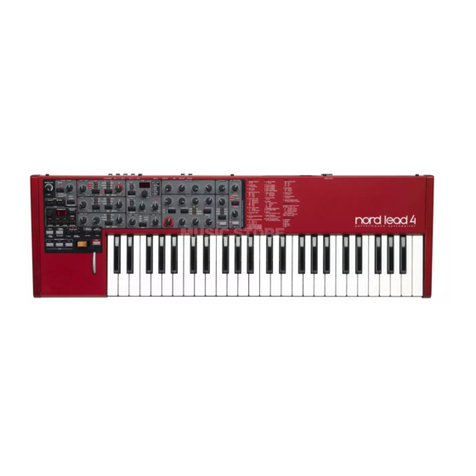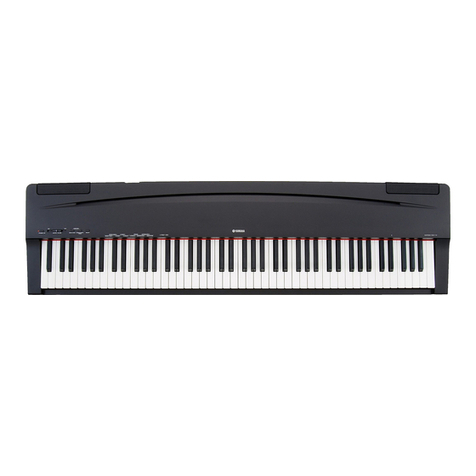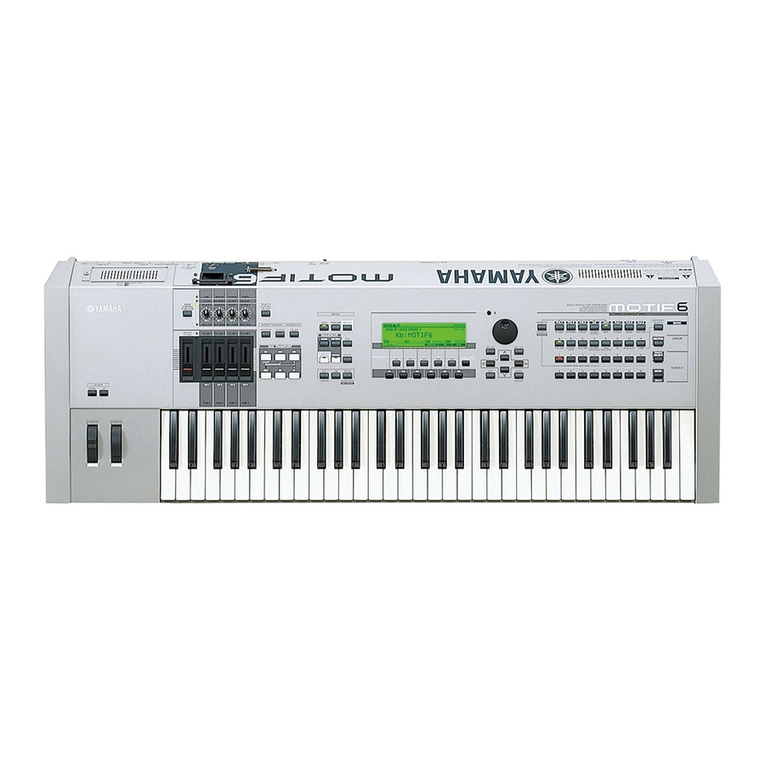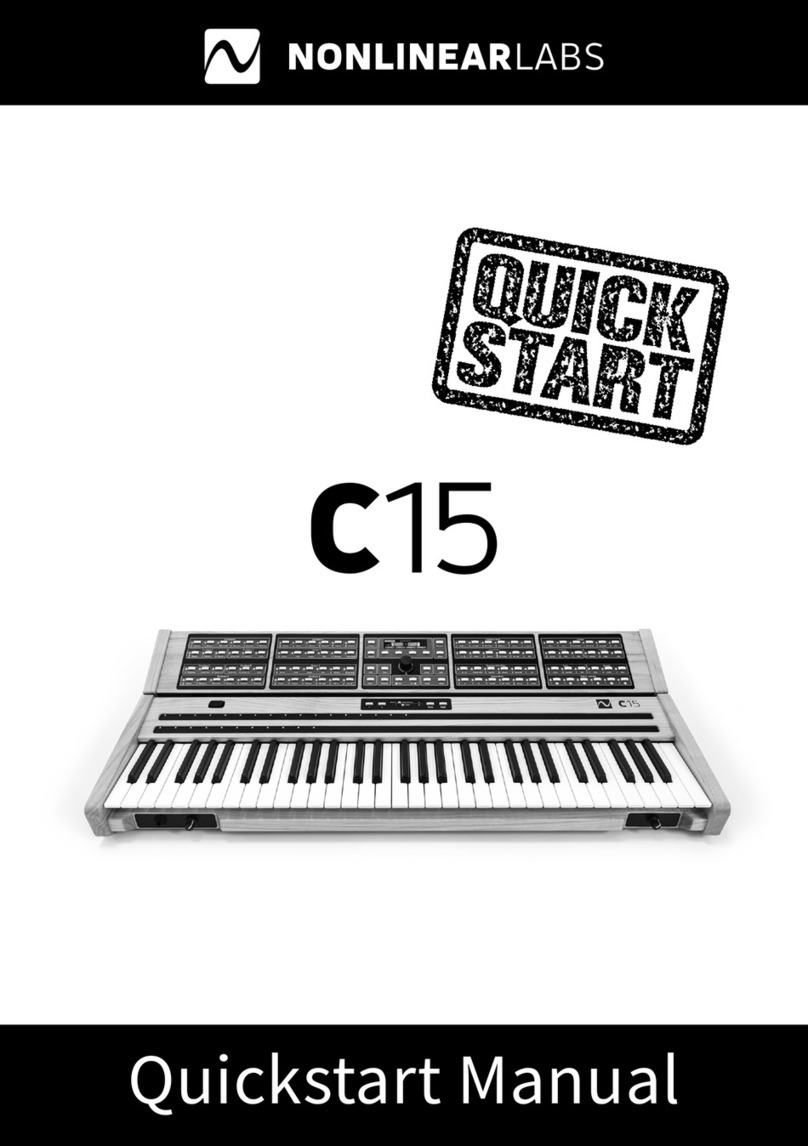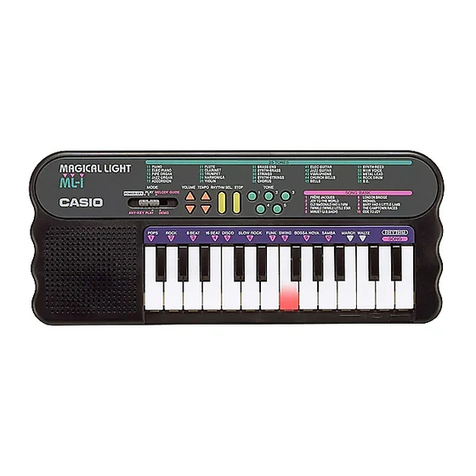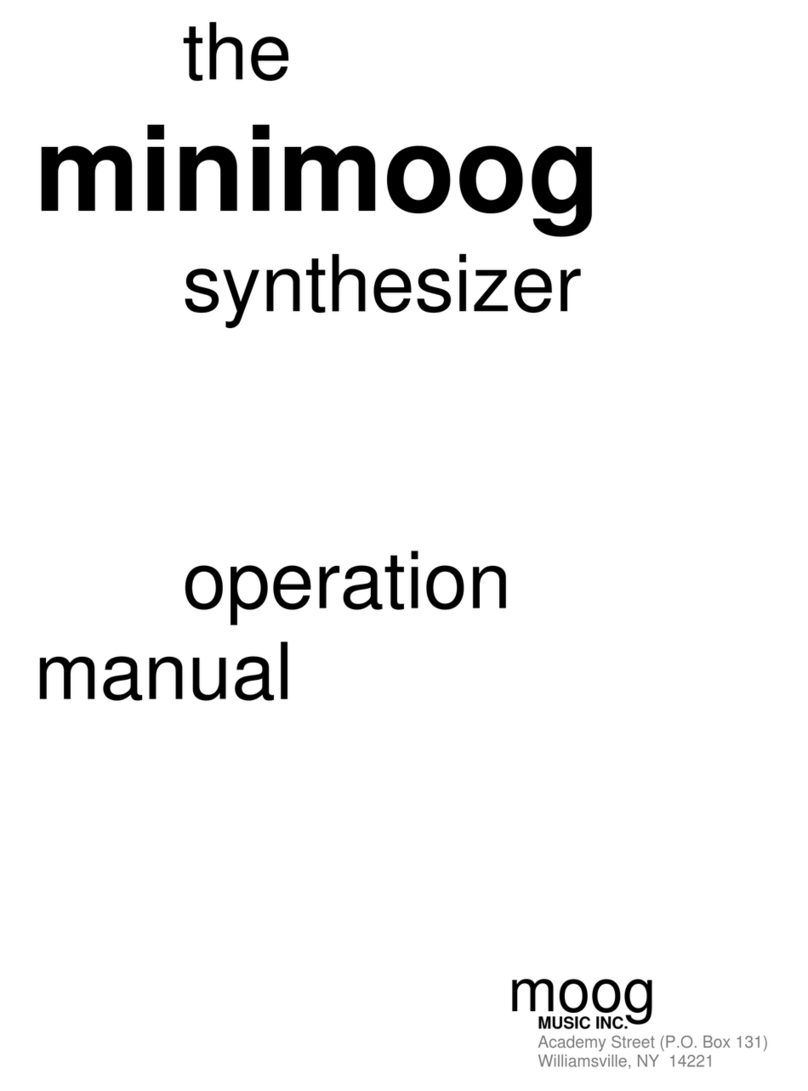Studio Electronics ATC-X User manual



FEATURES / VOICE ARCHITECTURE .............................................................. ii
IMPORTANT NOTES .................................................................................... 1
INTRODUCTION ......................................................................................... 2
B AS I C O P E R AT I O N
GETTING IT STARTED................................................................................... 3
CONNECTIONS .......................................................................................... 4
USING THE MEMBRANE AND ROTARY ENCODER (reading the display) ........... 5
C RE AT I N G S O U N D S
OSCILLATORS ........................................................................................ 6, 7
FILTER ....................................................................................................... 8
ENVELOPES .................................................................................... 9, 10, 11
MODULATION ................................................................................... 12, 12b
MIDI-KYBD .......................................................................................... 13, 14
PROGRAM (editing and saving patches) ....................................................... 15
T E C HN I CA L I N F O
LFO AND MIDI CONTROLLER ASSIGNMENTS ............................................. 16
MIDI IMPLEMENTATION CHART ................................................................. 17
SPECIFICATIONS ....................................................................................... 18
TROUBLE SHOOTING ................................................................................ 18

I. Portamento and auto glide.
II. Single and multiple triggering.
III. Inverting of envelopes 1 and 3.
IV. Note priority: low or last.
V. LFO 2 sync to MIDI clock with seven beat divisions: whole, half, quarter,
quarter note triplet, eighth, eighth note triplet, sixteenth, and sixteenth note
triplet.
VI. Assignable additional envelope.
VII. Audio frequency modulation of Oscillator 1 and filter by Oscillator 2.
VIII. Individual continuous controller assignments for all key sound parameters.
IX. Patch parameter edits from rotary encoder transmitted via MIDI.
X. Velocity sensitive.
XI. Extensive Modwheel and Aftertouch assignments.
XII. Holds 512 patches in RAM.
XIII. External input for audio signal processing.
XIV. Ringmod
Hardware:
A. Two voltage controlled oscillators with triangle, sawtooth, and square
waveforms.
The square waveform has variable pulse width control.
B. User selectable voltage controlled filters.
Types available:
Reproduction of the classic 24db MiniMoog low pass resonant filter
Reproduction of the boxy 12db Oberheim Synthesizer Expander
Module filter.
Reproduction of the unique and rare ARP 2600 filter
Reproduction of the Techno classic Roland TB-303 filter
C. White noise generator.
D. High dynamic gain voltage controlled amplifier.
Software:
A. Three four-stage envelopes with specially designed exponential curves.
Attack, decay, sustain, and release controls. Time range: 1 m.sec - 15 sec.
B.
Two low frequency oscillators with triangle, square, saw up, saw down, noise
and random waveforms. Frequency range: 0.1 hz - 50 hz

In addition to the aforementioned "Safety Instructions" printed on the inside front
cover, we (the goodly folks at S. E.) ask––nay, we implore!––you please read and
heed the following recommendations:
POWER SUPPLY CONCERNS
Turn off the power to all equipment before making any connections between devices. This will help to
prevent malfunction and likely speaker damage.
Be certain to use a separate power outlet for this unit, as sharing one with distortion producing devices
(such as motors, variable lighting devices) is unwise.
PLACEMENT CONCERNS
Placing the unit in close proximity to power amplifiers or equipment containing large transformers is likely
to induce hum.
If the unit is to be operated nearby T.V. or radio receivers, some type of interference might be noticeable.
In such cases, move the unit out of proximity with the entertainment devices.
MAINTENANCE
In hopes that you might keep the visuals of your treasured analog gem in tip top shape, our cleaning
specialists advise wiping ever so gently with a slightly dampened soft cloth. For those stains of a more
tenacious temperament add a mild detergent to the mix, always remembering to follow with that ubiquitous
"soft dry cloth".
Never apply solvents of any kind: benzene, paint thinner, propyl alcohol, etc., to avoid the risk of nasty
discoloration, disfigurement and most importantly, those deadly liver flukes. (It should be parenthetically
noted that neither solvents nor the unit itself are ever to be taken internally!)
OTHER PRECAUTIONS
Protect the unit from strong jolts and vibration, especially when standing on well-established fault lines.
Never apply strong pressure to the front, back or side panels, or strike them in any manner whatsoever.
It is normal and helpful for this synthesizer to generate a certain degree of heat.
MEMORY BACKUP CONCERNS
Within the unit is contained a battery which serves to maintain the contents of the memory when the power
is switched off. The normal life of this battery is 5 years or more. To prevent unintentional memory loss,
the battery must be replaced every 5 years as a rule. When it is time to change it, contact us, or your local
authorized Studio Electronics service station.
Please be aware that the contents of the memory may possibly be lost: when sent for repair work, or when
a chance malfunction occurs––it is always prudent to back up your complete memory via a SYSEX bulk
dump. Remember, each bank must be saved individually. When in the shop for repair, great care is taken
to avoid data loss, however In the event of damage to circuitry related to the memory system itself, you
are
sorry for Charlie
(emphasis Greg’s).

Thank you for purchasing the STUDIO ELECTRONICS ATC-X. You're soon to discover
the world's only 4-way discrete multi-filtered analog synthesizer. Like never before, you
now have the ability to create and explore all of the classic Analog synthesizer sounds in
one powerfully expressive and versatile machine.
The ATC-X is a truly modern Analog synthesizer, incorporating authentic discrete
component circuitry with complete MIDI implementation and total programmability.
Control of the parameters from the optical encoder is smooth and precise. Its creative and
intuitive design incorporates unique features and functions, allowing the discerning
musician complex tone manipulation and seemingly endless patch variations.
The electronically produced sound of the ATC-X is vibrant, warm and "punchy";
possessing the highly pleasing qualities of inherent randomness in pitch and timbre, like
those of a fine acoustic instrument.
We take great pride in manufacturing this instrument in "the land that the rivers have
quartered"––The United States of America and maintain the highest standards of quality
by meticulously procuring only the finest materials and carefully assembling each and every
S T U D I O E L E C T R O N I C S
product by hand.
It is our sincerest hope that the long anticipated ATC-X surpasses expectations and
provides decades of satisfaction, pleasure and performance.

Setting Up the Instrument
A. Plug the power supply cable into any conventional A.C. outlet. With its auto-
switching power supply the ATC-X is capable of accommodating voltages ranging
from 90 - 250. So, wherever you and your ATC-X are in this great big world, proper
operation is a cinch.
B. Use an appropriate patch-chord to connect the ATC-X to your sound monitoring
devices. To reproduce the full sound spectrum of which the synthesizer is capable, a
"high fidelity" P.A. system is required.
C. Flip the power switch on the back of the unit to the on position. Allow approximately
3 to 5 minutes for proper warm-up to assure tuning stabilization.
D. Enjoy the negative space that is the balance of this page.
Well almost: A 450 dpi print quality version of the Cover page is available for royalty-free
download at http://studioelectronics.com/assets/PDFs/ATC-X/ATCXCover.tiff.zip
And get these sounds: http://studioelectronics.com/products_atc-atcx_basses_and.php
They are vital…
We love you all. The interest and support of this growing S.E. sub-culture of folks with
really good ears make possible the sustainable life of the craftsman; the artisan; the
boutique perfectionist who knows little or nothing else––well he humors himself with
various and sundry disciplines, but his devotion remains pure: thanks to you, the customer!
MSR ’08 (First actual use of new year’s shorthand!)


The Membrane
The front panel membrane of the ATC–X contains an array of switches, with each colored
pad located atop a single switch. To access any function or parameter; press with light to
moderate force on the desired switch pad.
Some of the switch pads have dual or multiple functions; which when pressed more than
once access the next function. In addition, a few functions are accessed by pressing and
holding one switch pad, then immediately pressing another.
A complete list of the multiple and combination switch pad operations is listed on the
"QUICK REFERENCE GUIDE" sheet.
*Note that the display blinks momentarily after each press, informing you that your action has
been recognized.
The Rotary Encoder
The main user interface in programming the ATC-X is the rotary encoder; which turns
smoothly in either direction for complete control. After a switch pad is pressed you will use
the encoder in almost all operations to edit or change any desired function or parameter.
Edits to certain sound parameters are transmitted as MIDI controller data.
Reading the Display
The 3 digit L.E.D. on the ATC–X is used to display parameter values, function assignments,
and all operations in an alphanumerical format. Abbreviations are used for most of the
function assignments; refer to the "MASTER SYMBOL KEY" on the "QUICK REFERENCE
GUIDE" sheet for explanations of the three digit abbreviations.
Three periods or dots also appear which represent the following: the left two periods show
that the programmed patch has been edited, and the right period shows that a MIDI note has
been received.
If you are ever confused as to whether you are looking at a patch number or parameter value,
press exit/bank
exit/bank and you will return to the Patch Number Display Mode.
See PROGRAM.

The oscillators are the unmodified building
blocks of Analog synthesis. An oscillator
produces periodic or regularly repeating
waveforms, i.e. pitched sounds. The tuning
controls alter the frequency or pitch of the
oscillators. The waveshape selectors determine
the harmonic spectrum of the signal, its basic
timbre, or tone color.
The ATC-X 1 has two oscillators that each
produce three waveforms. All the waveforms are
continuously being generated, so they are
available to be outputted either individually or
simultaneously, depending upon how they are selected.
What the Switch pads do:
Selects the triangle waveform. Press once to display current patch setting then
press again to turn on or off. Triangle shaped waveforms produce smooth flute-
like tones (same for both oscillators).
Selects the sawtooth waveform. Press once to display current patch setting then
press again to turn on or off. Sawtooth shaped waveforms produce punchy brass-
like tones (same for both oscillators).
Selects the square waveform. Pressing will display the current pulse width
setting: use the encoder to edit. A true square wave will be obtained by setting
the pulse width at 60
60. Square shaped waveforms produce bright reed-like tones
(same for both oscillators).
Selects Oscillator 1 coarse-tuning. Provides continuous tuning of Oscillator 1;
raises or lowers the pitch in half-step increments. 0
0 is the lowest tuning, with
multiples of 12 being the octave intervals.
Selects Oscillator 2 tuning. Pressing once will select coarse tuning; pressing
again will select the fine-tuning. Continuous presses will toggle between coarse
and fine. Slightly detuning Oscillator 2 will add warmth and depth to the sound.
OSCILLATORS
continued on next page.

What the Switch pads do:
Selects the mix level of Oscillator 1. As the level is increased beyond 100
100 some
harmonic distortion may occur; which is quite normal depending upon how many
waveforms are selected and the settings of the filter.
Selects the mix level of Oscillator 2 (same potential for harmonic distortion as
Oscillator 1).
Selects the mix level of the noise or distortion. Noise is a random signal, a
rushing, static-like sound. The ATC-X's noise generator produces white noise.
White noise is composed of all frequencies in equal amounts. Note: The noise
may not be audible if the filter frequency is set too low. In lieu of Noise, press the
noise/dist
noise/dist button once to see which function is currently selected; press again
to toggle to the other function. Set the Noise level or Distortion amount using
the rotary encoder.
Selects the different pitch modes of Oscillator 2. The modes are as follows:
0 - normal operation
1 - Oscillator 2 is synced* to Oscillator 1
2 - No control voltage to Oscillator 2 (pitch does not track keyboard).
3 - No control voltage to Oscillator 2 and it is synced to Oscillator 1
*Forces the pitch of Oscillator 2 to follow the pitch of Oscillator 1 in hard
synchronization so it will therefore tune only to harmonic frequencies of
Oscillator 1. Intermediate frequencies of Oscillator 2 will produce unusual wave
shapes and timbres.

The ATC-X with its unique interchangeable filter system features four
classic wide range lowpass filters, and in the case of the MINI and
2600, "resonant" filters (see VOICE ARCHITECHURE). The Filter
attenuates, or "cuts- off" the higher frequency components––those
which lie above the adjustable cutoff frequency, and passes the lower
frequency components of the audio signal. The (cutoff) freq uen c y
fr eque nc y
control sets this cutoff frequency
frequency; the lower the value of the (cutoff)
frequency control, the less harmonic content the waveform contains
after passing through the filter. The wave shape is rounded and
smoothed as the cutoff frequency is lowered.
What the Switch pads do:
Selects the filter (cutoff) frequency. In simpler terms, the
filter frequency is like an overall tone control; as the value is increased from 0
0 -
-
12 7
12 7, the higher the frequencies are which pass through the filter; thus, the
brighter the sound.
Selects the filter resonance. The resonance emphasizes the cutoff frequency
region and makes the presence of harmonics more apparent. The MINI and 2600
filters will begin to self-oscillate, and may be used as a separate tone source,
when the resonance value passes 100.
100.
Selects the filter tracking amount. Filter tracking applies keyboard control voltage
to the filter. As more tracking is used, the brighter the sound will get as you
ascend the keyboard.
Selects the inverting of envelopes 1 (filter) and/or 3 (assignable). When an
envelope is inverted, the attack & decay controls are reversed and the sustain
value inverts. The Filter envelope is inverted when the display reads 1
1,
Envelope
3 is inverted when the display reads 3
3;
both Envelope 1 and 3 are inverted when
the display reads 1
1-
-3
3. Pushing the type/inv
type/inv button puts the ATC-X in filter
selection mode. Rotate the encoder knob to select the desired filter type for the
VCF section (Quad Filter System models only).
Selects Envelope 1 amount. The pattern of the filter envelope contouring is
determined by the envelope controls: attack, decay, sustain, and release. The
amount or depth of the envelope contouring is determined by this parameter.
Selects Envelope 3 amount. This is the amount of contour or depth of the
envelope as it is applied to the selected target (see page 11).

The filter envelope shapes the timbre and
overtone content of the audio signal as it passes
through the modifying circuitry from the mixer.
This envelope or "contour" generator is used to
dynamically move the cutoff frequency. It works
as such: each time a key is depressed an
envelope or "contour” generator attached to the
filter's cutoff frequency is actuated, and sends a
control signal to the filter. The control signal
rises at one rate, falls at a second rate, levels off
at a certain level, and then finally falls off at a
third rate. These four parameters and their effect
upon the cutoff frequency are explained below.
What the Switch pads do:
Selects the attack time. The attack time determines the initial segment of the
envelope. The frequency at which the contour begins is determined by the filter
frequency setting, while the peak, which it reaches, is determined by the filter
frequency and Envelope 1 amount settings combined. Incrementing the value
from 0
0 -
-127
127 will result in the brightness of the sound increasing sharply at first,
and then more gradually as the attack time lengthens.
Selects the decay time. The decay time determines the duration of the second
segment of the envelope, i.e., the fall from the attack peak to the sustain level.
While repeatedly depressing a key and incrementing the value from 0
0 -
-127
127 you
will at first hear the brightness drop sharply after the initial attack; the drop will
become more gradual as the decay time lengthens.
Selects the sustain level. The sustain level determines the filter frequency at
which the envelope "levels off" after the initial rise and fall. The frequency of the
sustain level can be as high as the initial peak, in which case there is no decay
after the initial rise, or it can be as low as the frequency at which the envelope
contour began.
Selects the release time and is the fourth and final stage of the envelope
contour. Finally, after the initial rise and fall of the attack and decay times to the
sustain level, the release time takes effect after the sustain level segment, when
the played key or note is lifted. The frequency at which the sustain level is set,
falls to the initial filter cutoff frequency level at the rate set by the release time.
ENVELOPES
continued on next page.

Envelope 2: VCA
The volume of the audio signal, which passes
through the VCA envelope, is contoured by the
envelope controls. Each time a key is pressed,
the envelope or "contour" generator attached
to the amplifier is actuated, and sends a control
signal to the amplifier. Like the filter envelope
control signal, the VCA envelope control signal is
composed of the same four segments: initial rise,
decay, sustain level, and release time. The
volume of the note is shaped according to the
settings of the envelope controls. These four parameters are shown below.
Selects the attack time. The attack time determines the duration of the initial rise
in volume to a peak. Notice the sound take on different qualities as you increase
from a short sharp attack to a long slow crescendo.
Selects the decay time. The decay time determines the duration of the drop in
volume from the initial peak to the sustain level. Shorter decay times will produce
more percussive sounds; the longer times will begin to "open" up the sound.
Selects the sustain level. The sustain level determines the volume level at which
the envelope contour levels off after the attack and decay. Set at 0
0, no sustain
level is heard. Set at 50
50, the contour diminishes to a low volume. Set at 127
127, no
drop in volume is heard after the initial peak is reached.
Selects the release time. The release allows the sound to fade out at the time set,
rather than immediately upon release of a note or key. This "final decay" takes
effect after the sustain level segment of the envelope.
ENVELOPES
continued (still) on next page.

Envelope 3: Assignab le
Envelope 3 can be assigned to modulate a
variety of different parameters to create unusual
textures and interesting effects.
See the target list below for the parameters
Envelope 3 can control.
What the Switch pads do:
The attack, decay, sustain, and release controls all function in the same manner for Envelope
3 as they do for the VCF and VCA envelopes. When a key is struck the control signal
modulates the assigned parameter's initial level to peak at the rate set by the attack time, the
peak then drops to the sustain level at the decay rate, the sustain level remains until the note
or key is lifted, then the release, if any, determines the rate at which the sustain level falls to
the initial level.
NOTE: pressing the decay switch pad a second time accesses the release time of Envelope 3.
The first press gives you control of the decay time and (to restate for clarity) the second press
gives you control of the release time.
Selects Envelope 3 assignment list. Possible assignments:
Target List
OSCILLATOR 1 PULSE WIDTH
OSCILLATOR 2 PULSE WIDTH
LFO 1 RATE
LFO 1 DEPTH
LFO 2 RATE
LFO 2 DEPTH
MAIN PITCH
OSCILLATOR 1 FREQUENCY
OSCILLATOR 2 FREQUENCY
OSCILLATOR 1 LEVEL
OSCILLATOR 2 LEVEL
XMOD LEVEL
NOISE LEVEL
FILTER RESONANCE
Refer to the "MASTER SYMBOL KEY" on the "QUICK REFERENCE GUIDE" sheet for precise
explanations of the three digit abbreviations.

Modulation is the use of a control signal to create a
repetitive pattern of pitch, level, or harmonic content
changes. The shape of the modulation is determined by the
waveform that the LFO outputs––selected by the wave
wave
switch pad. In addition to the four selectable waveshapes,
sample & hold and noise provide random modulation. The
amount of modulation is determined by either the depth
control or any assigned MIDI controller. The ATC-X's two
Low Frequency Oscillators, or LFO
LFOs, are assignable to a
variety of parameters, and LFO 2
LFO 2 can be synchronized to
MIDI time clock (see PROGRAM). The ATC-X also has the
capability of allowing Oscillator 2 to modulate Oscillator 1
and the frequency of the filter. This is known as Audio
Frequency Modulation because the modulation control signal, in this case Oscillator 2,
resides in the audio spectrum.
What the Switch pads do:
The switch pads for LFO 1 and 2 operate in the same manner:
rate/key
rate/key adjusting the frequency of the LFO and “key triggering”
the start of the LFO wave cycle, and depth/phase
depth/phase attenuating the
modulation signal and selecting the up or down start point of the
LFO wave cycle. To select the sound source or parameter to be
modulated by the LFO, press the target
target switch pad (see page 15
for the LFO assignment list). To enable key triggered LFO wave
cycling––each new note initiating the start of the wave cycle––press
the rate/key
rate/key LFO 1
LFO 1 or LFO 2
2 twice and turn encoder to select. To
invert the phase––select the up or down start point of the LFO wave
cycle––press the depth/phase
depth/phase twice and turn encoder to select.
Selects the audio frequency modulation assignment - Oscillator 1, Filter
frequency, or both. The frequency of Oscillator 1 is modulated by the audio
output of Oscillator 2 when the display reads OSC
OSC. The frequency of the
Filter is modulated by the audio output of Oscillator 2 when the display
reads VCF
VCF and both are modulated by Oscillator 2 when the display reads
O
O-
-F.
F.
Selects the amount of Audio Frequency Modulation. Use this control in
conjunction with Oscillator 2 frequency and mode 2 to create often-
clangorous effects. The second press of the X AMNT/RMOD button brings
up the ring mod function for editing. Use the encoder knob to set the
desired ring mod depth between oscillators 1 & 2. A setting of '0' is = OFF
(hardware patchable via back panel connections).

Selects LFO 1 and 2 waveforms. Press once for LFO 1 waveform selection,
press again for LFO 2 waveform selection. Continuous presses will toggle
the LFOs (see the "QUICK REFERENCE GUIDE" sheet for waveform
number definitions).
Void below vintage NAMM Show banner reserved for doodling, grease stains and sectional
integrity (by mercurial order of the Knights Regis). May it serve and soothe you well.
Pimp your wall: full-sized, color banner art available at:
http://studioelectronics.com/assets/PDFs/ATC-X/NAMM97Banner.tif.zip

The ATC-X is completely controllable by MIDI, with a long
list of parameters and functions assignable to Velocity,
Modwheel, and Aftertouch. Certain sound parameters also
have a dedicated Continuous Controller assignment (see
chart on page 16). In addition, parameter edits made by the
rotary encoder are transmitted as Controller data. This
extensive MIDI implementation allows for an almost
unlimited expression of tone and timbre manipulation,
which can be recorded to any MIDI sequencer.
What the Switch pads do:
Selects the velocity sensitivity of Envelope amounts 1, 2, and 3. Press once to
access Envelope 1; the display will read: EA1
EA1. To change the value, use the
encoder––press again to access Envelope 2; the display will read: EA2
EA2. Use the
encoder to edit––pressing a third time accesses Envelope 3; the display will read:
EA3
EA3. Follow with the encoder to change the value. An edit to the patch to be
made to display the current value of a parameter selected.
Selects the Modwheel assignment and its sensitivity. Press once to access the
assignment list, press again to access the sensitivity amount. The Modwheel can
control only one parameter at a time (see page 16 for the complete assignment
list).
Selects the Aftertouch assignment and its sensitivity. Press once to access the
assignment list; press again to access the sensitivity amount. Only one parameter
at a time can be controlled by Aftertouch. Assignments for Aftertouch are the
same as for the Modwheel. Aftertouch/Pressure destinations are also assignable
to Modwheel––allows Modwheel to control two simultaneous modulation targets
with independent depths (tricky… but rewarding). Doubling up protocol:
Press and hold pressure then press exit. Display will show on/off. Keep holding
pressure while pressing exit button to toggle on or off. Off means that pressure
will not be received and that Modwheel will control the pressure assignment.
Program the desired pressure (now Modwheel) assignment and depth as usual.
Release pressure and press any other button to exit this mode. Note: unless so
programmed, the pressure info sent from keyboard or sequencer is received as
Aftertouch/Pressure info.
Selects the Pitch Bend control range of the oscillators and the filter. Press once
to access the oscillators; the display will read: OSC
OSC. Use the encoder to change
the value––press again to access the filter; the display will read: VCF
VCF. Use the
encoder to edit. An edit to the patch to be made to display the current value of a
parameter selected.

Selects the MIDI clock assignment to LFO 2. The rate of LFO 2 can be
synchronized to incoming MIDI time clock sent from your sequencer. The beat
divisions available are:
1
1 = whole note, 2
2 = half note, 4
4 = quarter note, 4
4-
-3
3 = quarter note triplet, 8
8 =
eighth note, 8
8-
-3
3 = eighth note triplet, 16
16 = sixteenth note, 16
16 -
-3
3 = sixteenth
note triplet. Note: LFO 2 rate control will not respond when a MIDI clock division
is selected.
Selects the master tuning and overall transpose.
Press once to access the master tune control
which raises or lowers the pitch of the
oscillators over a semitone range; Press again to
access the overall octave transpose. The pitch
can then be transposed up or down one octave.
Selects the master volume level. We
recommend this level be set at maximum or
close to it, for the best possible sound quality.
Selects the glide time and auto glide interval
and regular or legato functions. Glid
Glid e
e is pitch
movement from note to note at a selected rate
and Auto
Auto -
-Glide
Glide is pitch movement from a
selected interval at a rate determined by the glide time. Note: If the auto-glide
interval is anything but 0
0, the auto glide function will override glide. First press:
glide on/off. Second press: regular mode or legato mode (notes will only glide if
legato notes are played). Third press: glide rate. Fourth press: Auto-glide interval.
Note: with all presses, use encoder to edit.
To defeat of glide to OSC 1, 2 or VCF (cool effects yo) frequency, edit thusly:
OSC 1: press and hold glide button then press OSC 1 frequency. Release glide button and
use OSC 1 frequency button to toggle on or off. Press any other button to exit this mode.
OSC 2: press and hold glide then OSC freq/fine. Release glide button and use OSC 2
freq/fine button to toggle on or off. Same exit strategy.
VCF frequency: press and hold glide button then press VCF frequency. Release glide
button and use OSC 2 freq/fine button to toggle on or. Ditto exit plan.
Note: unless programmed all patches will default to glide being sent to all sources.
Selects the key triggering and note priority functions. Press once to access single
or multiple triggering selections. Press again to access note priority selection.
Multiple
Multiple triggering
triggering is the re-triggering of the filter envelope with each note or
keystroke; with single triggering the filter envelope is re-triggered only with
staccato, or non-legato key strikes. Note Priority
Note Priority determines if while a holding
note, any new note, or a lower note only, will be played next.

Located in this section is the display and rotary encoder, which along
with the membrane front panel, makeup the user interface. Playing
and programming the ATC-X involves two basic modes of operation:
Patch Play Mode and Edit Mode. In Patch Play mode, the unit will
cycle through its 512 patches when the encoder is turned. The ATCX
enters Edit Mode when any parameter or function of a patch is
selected, at which the edit periods will appear. You are always in Patch
Play Mode, when A: no editing has been done; B: you have just saved
a patch; C: you have exited the edit mode by pressing exit/bank
exit/bank, and
D: upon power up.
With the exit/bank
exit/bank and save
save switch pads, the basic utility functions
of the unit are performed. These two do the work of six. Read the
instructions below carefully to fully understand each operation.
To Save a patch: To save a sound to the patch memory, press save
save once; the display
will flash the current patch number, pressing save
save again will record it to its current location;
to save the sound to a new location, rotate the encoder to the desired number, then press
save
save once again.
To Exit an edited patch: If at any time after editing a patch you wish to return to the
Patch Number Display Mode, press the exit/bank
exit/bank switch pad.
To Compare an edited patch: After a patch has been edited, press and hold
exit/bank
exit/bank then press save. You will then hear the un-edited originally saved patch, at this
point no switch pad will be recognized, except for exit/bank
exit/bank: press this to get back to the
edited patch. The display and encoder will return to the last edited parameter. Remember, a
sound must first be edited to use this function.
To change the MIDI Channel: The MIDI channel can be changed only, before a
patch has been edited. Press and hold exit/bank,
exit/bank, then press save
save; the display will show the
current MIDI channel - use the encoder to edit. This is the same procedure required to
"edit/compare” except that it must be performed prior to any patch editing.
To quickly change the memory Bank: Once again this is done only before a
patch has been edited. Press and hold exit/bank
exit/bank then rotate the encoder. The patch
number will change in increments of 128 steps in either direction.
To initiate a SYS EX bank dump: Press and hold save
save, and then press
exit/bank
exit/bank. Each bank is transmitted individually. To send a SYSEX dump of bank 1, set patch
number to 1
1; to send bank 2, set patch number to 129
129; to send bank 3, set patch number to
25 7
25 7; to send bank 4, set patch number to 385
385.
Table of contents
Other Studio Electronics Synthesizer manuals
Popular Synthesizer manuals by other brands
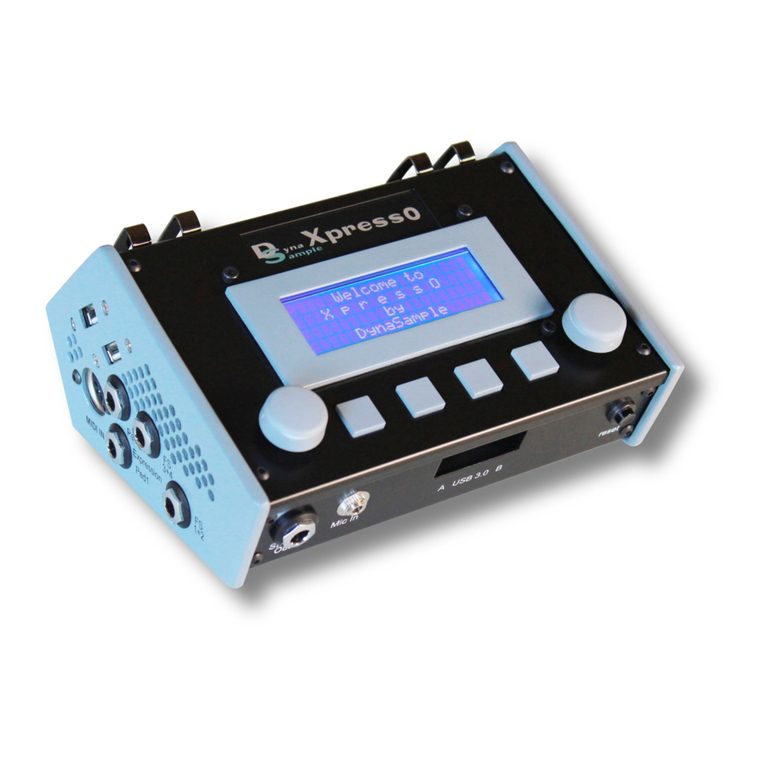
DynaSample
DynaSample XPression How to set up
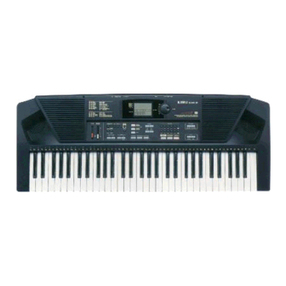
Kawai
Kawai X140-D owner's manual
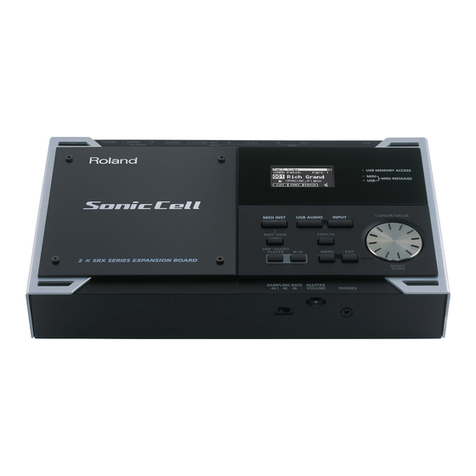
Roland
Roland SonicCell Stuff To Know
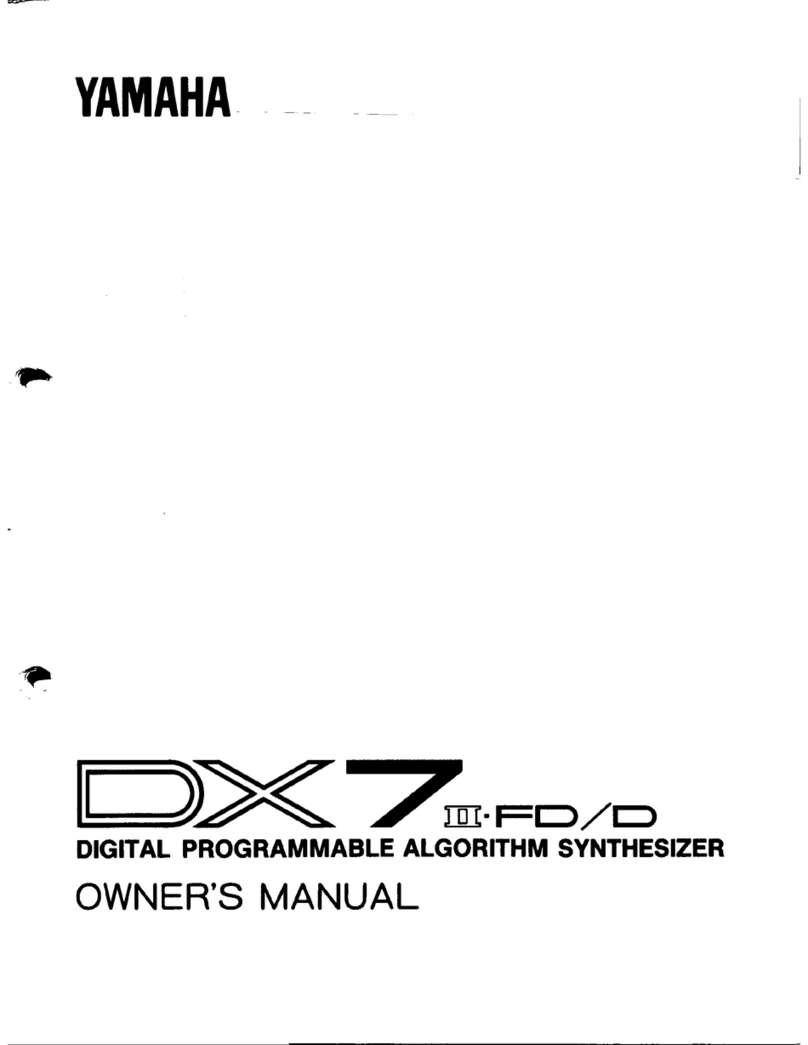
Yamaha
Yamaha DX7II-FD/D owner's manual
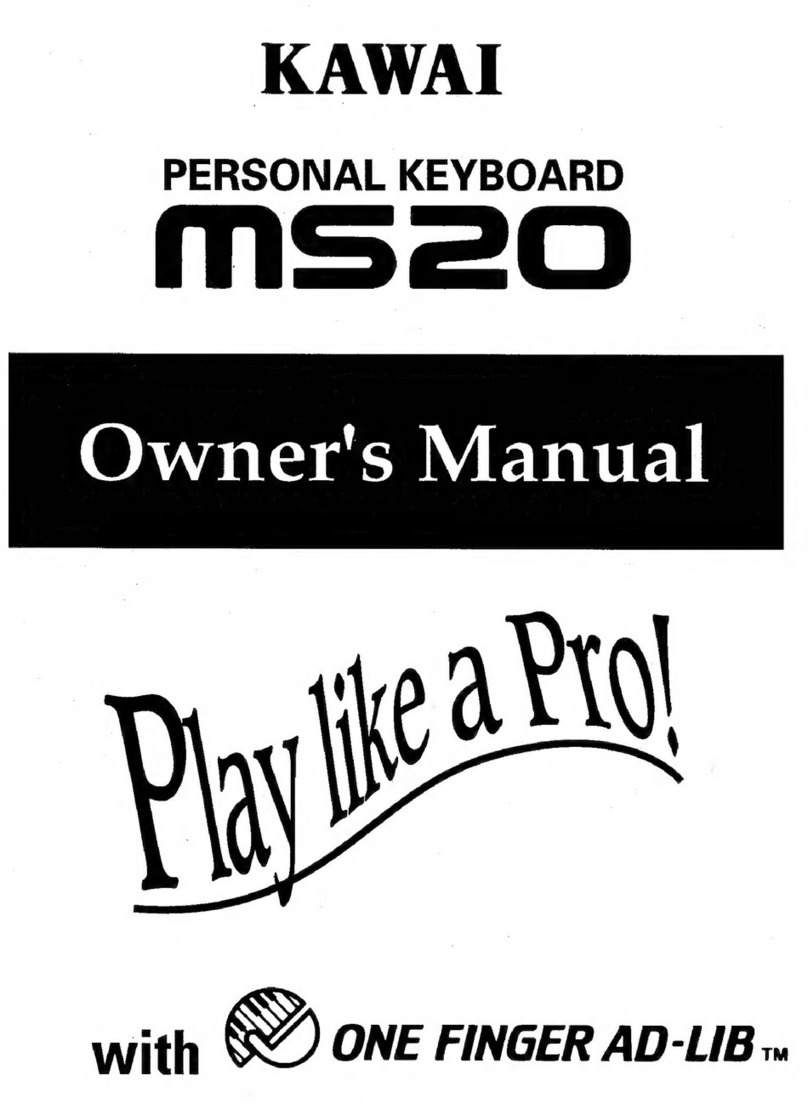
Kawai
Kawai Personal Keyboard MS20 owner's manual
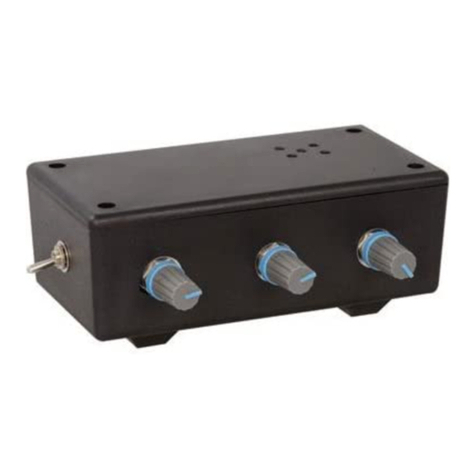
Jameco Electronics
Jameco Electronics FORREST M. MIMS III: ATARI PUNK CONSOLE KIT Assembly instructions
